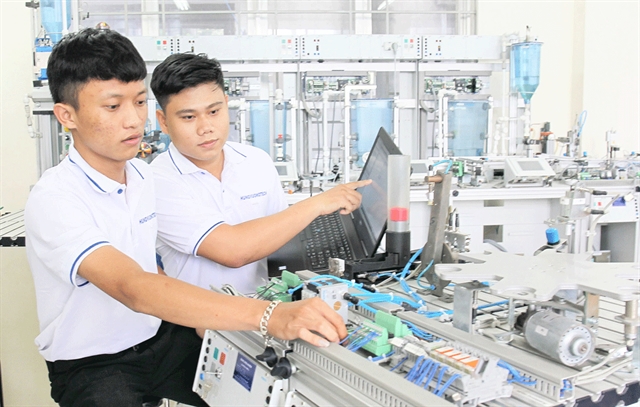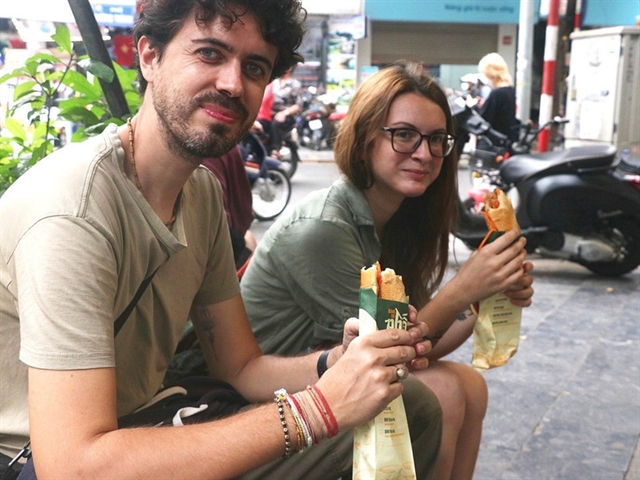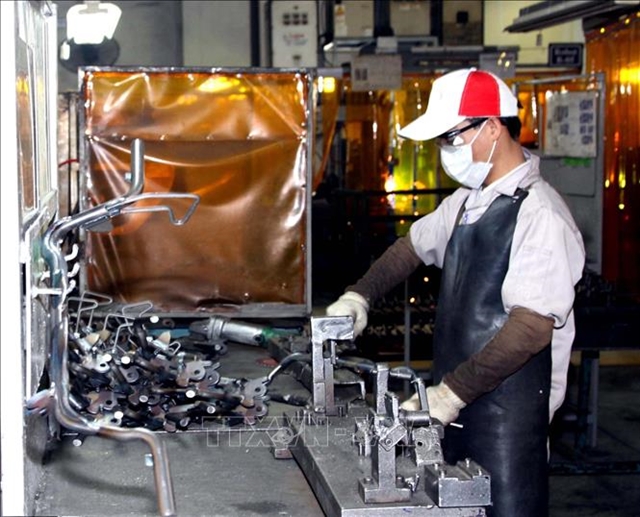 Society
Society


|
| Students practise at the Hùng Vương Technology Secondary School in HCM City’s District 5. — Photo www.sggp.org.vn |
HCM CITY — Vocational training programmes in HCM City have narrowed the gap between employers' expectations and employees' qualifications thanks to cooperation between vocational schools and businesses.
Lê Minh Tấn, director of the city Department of Labour, Invalids and Social Affairs, said the rate of trained workers in the city was 85.2 per cent in the 2015-20 period, compared to the target of 85 per cent.
Of the figure, 87 per cent of workers in industry and service sectors have received training.
“The positive results in vocational training have significantly improved the quality of human resources,” Tấn said.
The city has built 14 high-quality vocational schools, offering major disciplines associated with the city’s spearhead business fields. The quality of the programmes has improved over the years, with over 85 per cent of graduates getting jobs.
Cao Văn Minh, a student at Hùng Vương Technology Secondary School in District 5, said he had decided to switch to vocational school when he was a second-year student at the HCM City University of Transport.
He won a gold medal for maintenance of computer numerical control (CNC) machine tools at the 2018 national skills contest held in Hà Nội.
“My parents were very happy and realised that I had made the right choice,” he said.
He began working at DENSO Vietnam Co. Ltd, after graduation at a monthly salary of nearly VNĐ20 million (US$860).
He also acts as a link between the school and his company, which offers internship opportunities to students.
Training in key industries
The city's four key sectors with a high need for employees include manufacturing, electronics-information technology, food processing, and chemicals-plastics-rubber.
Phạm Quang Tuấn, vice principal at Thủ Đức College of Technology, said the college admits more than 3,000 new students every year. About 7,000 people enroll in short-term and primary courses at the college each year.
The college has training programmes in cooperation with international schools in Japan and Germany. Graduates can obtain two degrees through dual-degree training programmes and have a chance to work at branches of the Freesia Group in Việt Nam, Japan or Taiwan (China).
Through cooperation between the school and 500 businesses, about 80 per cent of students from the school can find a job after graduation.
The college has also developed vocational training strategies for occupations at the national, regional and international levels. It offers seven training majors that are included in the city’s list of key occupations.
Graduates can find jobs with a salary from VNĐ7-10million ($300-430) per month.
Phạm Quang Trang Thủy, principal at the Hùng Vương Technology Secondary School, also offers occupations following the city’s four key sectors such as mechatronics, maintenance of mechanical equipment, metal cutting, and others.
Most graduates can find a job related to their majors with a salary ranging from VNĐ7-15million ($300-650) per month, depending on their skills and the job.
Since 2018, the school has had linkages with 500 enterprises that support students with tuition fees and jobs.
Lê Minh Tấn said the city would continue to improve vocational training programmes to help narrow the gap between labourers' skills and labour market needs.
It will focus on working skills such as teamwork, independent work and interdisciplinary work. It will also raise awareness about innovative ideas, promote the start-up spirit among trainees, and build training programmes that meet regional and international standards with assessment of foreign language proficiency.
“This will help labourers adapt well to different working environments, especially to new kinds of jobs created in 4.0 industry,” Tấn said.
More than 671,200 new jobs were created in the city in the last five years, exceeding the target of 625,000 new jobs.
The city has provided jobs during that period to an average of 312,600 people each year, an increase of 8.4 per cent compared to the 2010-2015 period.
Many direct and online job transaction floors have been organised to help employees find suitable jobs.
Employees have also changed their mindset about applying for a job, seeking work in jobs in high demand. — VNS




